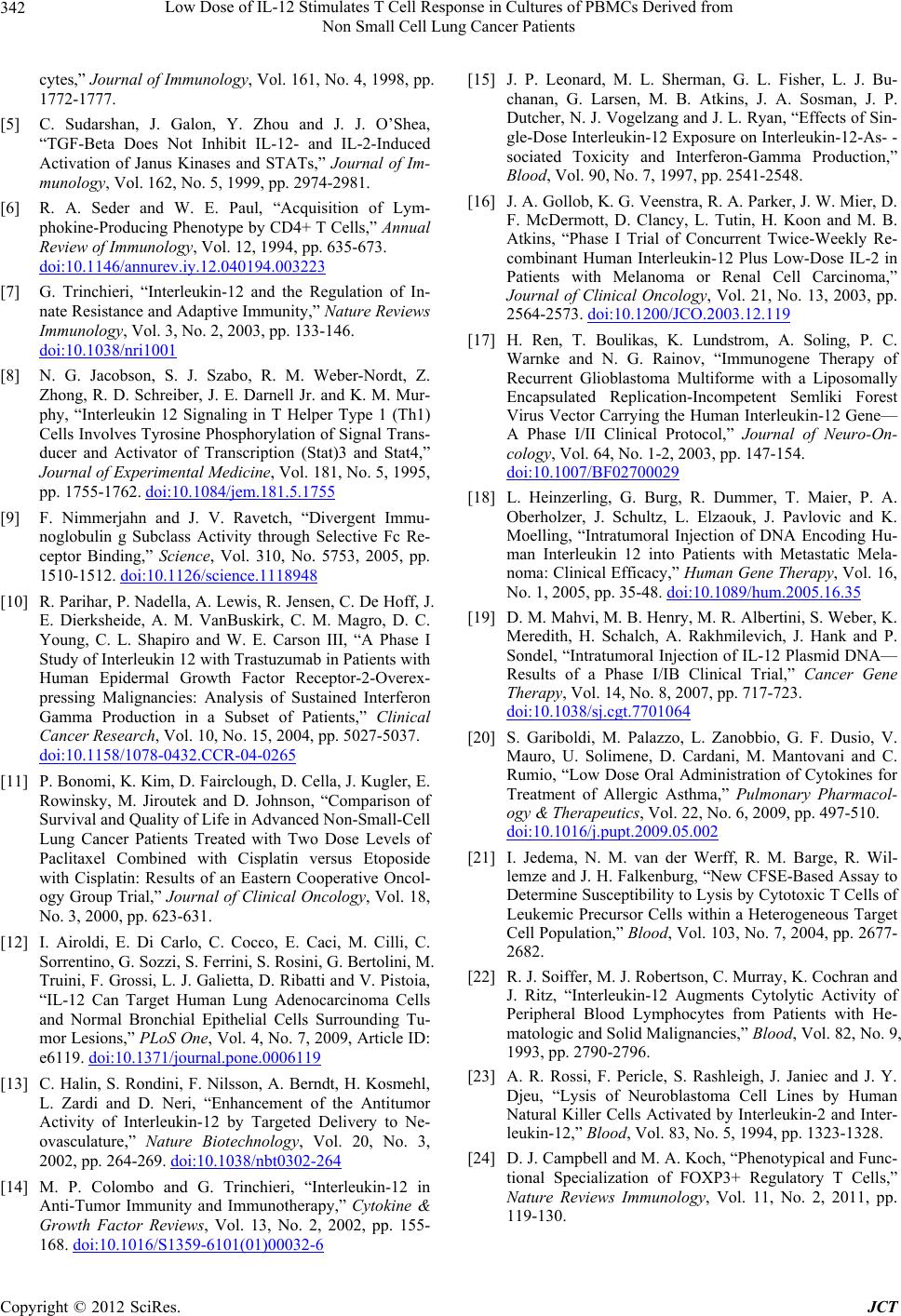
Low Dose of IL-12 Stimulates T Cell Response in Cultures of PBMCs Derived from
Non Small Cell Lung Cancer Patients
342
cytes,” Journal of Immunology, Vol. 161, No. 4, 1998, pp.
1772-1777.
[5] C. Sudarshan, J. Galon, Y. Zhou and J. J. O’Shea,
“TGF-Beta Does Not Inhibit IL-12- and IL-2-Induced
Activation of Janus Kinases and STATs,” Journal of Im-
munology, Vol. 162, No. 5, 1999, pp. 2974-2981.
[6] R. A. Seder and W. E. Paul, “Acquisition of Lym-
phokine-Producing Phenotype by CD4+ T Cells,” Annual
Review of Immunology, Vol. 12, 1994, pp. 635-673.
doi:10.1146/annurev.iy.12.040194.003223
[7] G. Trinchieri, “Interleukin-12 and the Regulation of In-
nate Resistance and Adaptive Immunity,” Nature Reviews
Immunology, Vol. 3, No. 2, 2003, pp. 133-146.
doi:10.1038/nri1001
[8] N. G. Jacobson, S. J. Szabo, R. M. Weber-Nordt, Z.
Zhong, R. D. Schreiber, J. E. Darnell Jr. and K. M. Mur-
phy, “Interleukin 12 Signaling in T Helper Type 1 (Th1)
Cells Involves Tyrosine Phosphorylation of Signal Trans-
ducer and Activator of Transcription (Stat)3 and Stat4,”
Journal of Experimental Medicine, Vol. 181, No. 5, 1995,
pp. 1755-1762. doi:10.1084/jem.181.5.1755
[9] F. Nimmerjahn and J. V. Ravetch, “Divergent Immu-
noglobulin g Subclass Activity through Selective Fc Re-
ceptor Binding,” Science, Vol. 310, No. 5753, 2005, pp.
1510-1512. doi:10.1126/science.1118948
[10] R. Parihar, P. Nadella, A. Lewis, R. Jensen, C. De Hoff, J.
E. Dierksheide, A. M. VanBuskirk, C. M. Magro, D. C.
Young, C. L. Shapiro and W. E. Carson III, “A Phase I
Study of Interleukin 12 with Trastuzumab in Patients with
Human Epidermal Growth Factor Receptor-2-Overex-
pressing Malignancies: Analysis of Sustained Interferon
Gamma Production in a Subset of Patients,” Clinical
Cancer Research, Vol. 10, No. 15, 2004, pp. 5027-5037.
doi:10.1158/1078-0432.CCR-04-0265
[11] P. Bonomi, K. Kim, D. Fairclough, D. Cella, J. Kugler, E.
Rowinsky, M. Jiroutek and D. Johnson, “Comparison of
Survival and Quality of Life in Advanced Non-Small-Cell
Lung Cancer Patients Treated with Two Dose Levels of
Paclitaxel Combined with Cisplatin versus Etoposide
with Cisplatin: Results of an Eastern Cooperative Oncol-
ogy Group Trial,” Journal of Clinical Oncology, Vol. 18,
No. 3, 2000, pp. 623-631.
[12] I. Airoldi, E. Di Carlo, C. Cocco, E. Caci, M. Cilli, C.
Sorrentino, G. Sozzi, S. Ferrini, S. Rosini, G. Bertolini, M.
Truini, F. Grossi, L. J. Galietta, D. Ribatti and V. Pistoia,
“IL-12 Can Target Human Lung Adenocarcinoma Cells
and Normal Bronchial Epithelial Cells Surrounding Tu-
mor Lesions,” PLoS One, Vol. 4, No. 7, 2009, Article ID:
e6119. doi:10.1371/journal.pone.0006119
[13] C. Halin, S. Rondini, F. Nilsson, A. Berndt, H. Kosmehl,
L. Zardi and D. Neri, “Enhancement of the Antitumor
Activity of Interleukin-12 by Targeted Delivery to Ne-
ovasculature,” Nature Biotechnology, Vol. 20, No. 3,
2002, pp. 264-269. doi:10.1038/nbt0302-264
[14] M. P. Colombo and G. Trinchieri, “Interleukin-12 in
Anti-Tumor Immunity and Immunotherapy,” Cytokine &
Growth Factor Reviews, Vol. 13, No. 2, 2002, pp. 155-
168. doi:10.1016/S1359-6101(01)00032-6
[15] J. P. Leonard, M. L. Sherman, G. L. Fisher, L. J. Bu-
chanan, G. Larsen, M. B. Atkins, J. A. Sosman, J. P.
Dutcher, N. J. Vogelzang and J. L. Ryan, “Effects of Sin-
gle-Dose Interleukin-12 Exposure on Interleukin-12-As- -
sociated Toxicity and Interferon-Gamma Production,”
Blood, Vol. 90, No. 7, 1997, pp. 2541-2548.
[16] J. A. Gollob, K. G. Veenstra, R. A. Parker, J. W. Mier, D.
F. McDermott, D. Clancy, L. Tutin, H. Koon and M. B.
Atkins, “Phase I Trial of Concurrent Twice-Weekly Re-
combinant Human Interleukin-12 Plus Low-Dose IL-2 in
Patients with Melanoma or Renal Cell Carcinoma,”
Journal of Clinical Oncology, Vol. 21, No. 13, 2003, pp.
2564-2573. doi:10.1200/JCO.2003.12.119
[17] H. Ren, T. Boulikas, K. Lundstrom, A. Soling, P. C.
Warnke and N. G. Rainov, “Immunogene Therapy of
Recurrent Glioblastoma Multiforme with a Liposomally
Encapsulated Replication-Incompetent Semliki Forest
Virus Vector Carrying the Human Interleukin-12 Gene—
A Phase I/II Clinical Protocol,” Journal of Neuro-On-
cology, Vol. 64, No. 1-2, 2003, pp. 147-154.
doi:10.1007/BF02700029
[18] L. Heinzerling, G. Burg, R. Dummer, T. Maier, P. A.
Oberholzer, J. Schultz, L. Elzaouk, J. Pavlovic and K.
Moelling, “Intratumoral Injection of DNA Encoding Hu-
man Interleukin 12 into Patients with Metastatic Mela-
noma: Clinical Efficacy,” Human Gene Therapy, Vol. 16,
No. 1, 2005, pp. 35-48. doi:10.1089/hum.2005.16.35
[19] D. M. Mahvi, M. B. Henry, M. R. Albertini, S. Weber, K.
Meredith, H. Schalch, A. Rakhmilevich, J. Hank and P.
Sondel, “Intratumoral Injection of IL-12 Plasmid DNA—
Results of a Phase I/IB Clinical Trial,” Cancer Gene
Therapy, Vol. 14, No. 8, 2007, pp. 717-723.
doi:10.1038/sj.cgt.7701064
[20] S. Gariboldi, M. Palazzo, L. Zanobbio, G. F. Dusio, V.
Mauro, U. Solimene, D. Cardani, M. Mantovani and C.
Rumio, “Low Dose Oral Administration of Cytokines for
Treatment of Allergic Asthma,” Pulmonary Pharmacol-
ogy & Therapeutics, Vol. 22, No. 6, 2009, pp. 497-510.
doi:10.1016/j.pupt.2009.05.002
[21] I. Jedema, N. M. van der Werff, R. M. Barge, R. Wil-
lemze and J. H. Falkenburg, “New CFSE-Based Assay to
Determine Susceptibility to Lysis by Cytotoxic T Cells of
Leukemic Precursor Cells within a Heterogeneous Target
Cell Population,” Blood, Vol. 103, No. 7, 2004, pp. 2677-
2682.
[22] R. J. Soiffer, M. J. Robertson, C. Murray, K. Cochran and
J. Ritz, “Interleukin-12 Augments Cytolytic Activity of
Peripheral Blood Lymphocytes from Patients with He-
matologic and Solid Malignancies,” Blood, Vol. 82, No. 9,
1993, pp. 2790-2796.
[23] A. R. Rossi, F. Pericle, S. Rashleigh, J. Janiec and J. Y.
Djeu, “Lysis of Neuroblastoma Cell Lines by Human
Natural Killer Cells Activated by Interleukin-2 and Inter-
leukin-12,” Blood, Vol. 83, No. 5, 1994, pp. 1323-1328.
[24] D. J. Campbell and M. A. Koch, “Phenotypical and Func-
tional Specialization of FOXP3+ Regulatory T Cells,”
Nature Reviews Immunology, Vol. 11, No. 2, 2011, pp.
119-130.
Copyright © 2012 SciRes. JCT